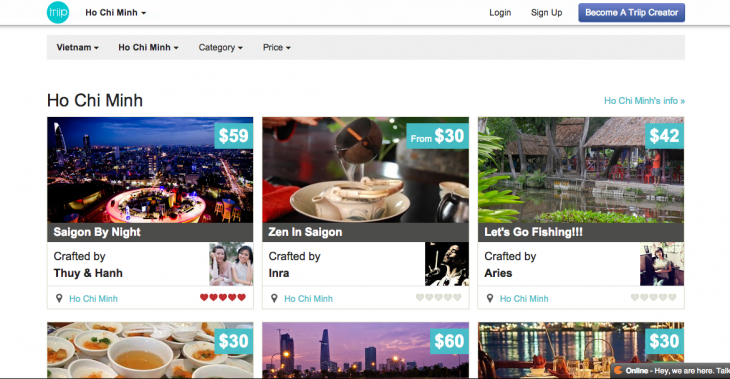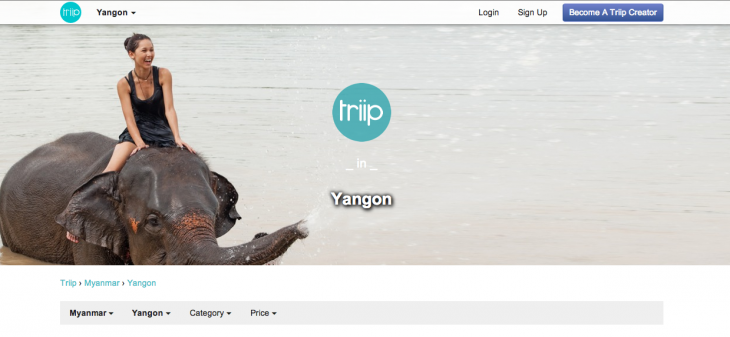
Had enough of haggling with local tour guides to make sure you’re not being scammed, or getting sick and tired of being herded to overly-touristy destinations when traveling with a tour package, but can’t imagine going through the laborious logistics of planning a free-and-easy trip?
Traveling is meant to open your eyes to the world, and there really is no better way than to let the locals show you around, but it isn’t easy at all to find locals who can speak your language and have the patience to spend time with you.
Triip, a travel platform currently operating only in Southeast Asia (but with plans to go global by 2016) is making it easier for tourists who want a taste of the local flavor — by connecting them with locals who craft private tours.
Triip lets tourists experience local life
The concept behind Vietnam-based Triip is not new — there are already other competitors such as ToursByLocals and Viator among others — but founder and serial entrepreneur Hai Ho (who was previously in charge of software product for mobile healthcare startup Misfit Wearables) says that in the long-term, Triip will spend much more time and resources to make use of big data for personalized recommendations, an approach that has been highly popular of late.
Hai Ho also notes that with Vietnam as a base, where hiring talent comes at a much lower cost than in the Western parts of the world, customer care is another competitive advantage Triip wants to leverage. He says: “In Vietnam we have the resources to handle a call center to take care of the problems.”
The founder adds that in the short term, Triip has been the only one to build a native app to support customers. The iOS app, Wiki Triip, is an offline travel guide that lists travel articles and acts as a complement to the Web-based booking service.
In any case, to dispel any notions of copy-catting, the idea for Triip was born seven years ago, when Hai Ho and his wife started organizing an initiative whereby Vietnamese students learning English held free tours in Ho Chi Minh city, so as to interact with foreigners. That grew popular and sparked the inspiration for Triip.
The first version of Triip was launched in February. Currently, Triip has 1,500 registered users and 200 qualified tours in 25 cities across Southeast Asia. It has more than 700 trip creators and is currently recording a growth rate of 15 new trips being created per week. The service is currently only Web-based but has a responsive website for you to make bookings via your mobile device easily.
What sets Triip apart is probably how much detail it pays to screening its tour guides. Hai Ho says: “We are quite strict in the quality of the tours. There has to be a story behind (the tour): you have to go to Point A then point B and do activities, as there are so many untold stories about the place… We push our Triip creators to tell stories not just showing people around.”
Triip holds Skype interviews with prospective tour guides, and holds the money paid by travelers until three days after the tour is complete. If there are no complaints, the money will then be transferred to the creator.
This means that all the tours have a local flavor that cannot really be matched by commercial tours. For example, a tour to Sapa — a frontier town in northwest Vietnam popular with tourists — created on Triip features a little-known village called Sin Chai, where tourists can interact with the kids and take lunch inside a local’s home.
When asked how Triip differentiates itself from those (much) cheaper commercial package tours being sold in the streets of Southeast Asia, Hai Ho notes that Triip only offers private tours. He also realized that at the end of the day, even though Triip lists tours with a good mix of those in the $20 range, it has been “quite surprising” that the best-selling ones are mid-priced tours for $50 or $60.
“People already booked their tickets to fly so far to Southeast Asia, so they don’t want to risk their experience by trying something cheap,” Hai Ho says.
Triip has the potential to go global
Triip has been gaining traction rapidly in its base country via Facebook, as according to Hai Ho “the young generation in Vietnam is quite savvy about travel and technology”. As of now, it has about 9,000 fans on Facebook. Hai Ho notes that it is a good side-job for students wanting to earn some pocket money.
However, this doesn’t limit Triip to only Southeast Asia. The concept behind Triip can be easily replicated from this region to the rest of the world — and Triip has already planned to make inroads throughout the whole of Asia by 2015 and throughout the world by 2016. All Triip needs is a lot of human resources — as it requires plenty of on-the-ground work to ensure the quality of tours.
Right now, Triip is working toward being featured on TripAdvisor and Lonely Planet as “once we’re listed here people will trust us”.
“Travelers are (a) very doubting kind of creature,” Hai Ho says. “It doesn’t matter how beautiful your website is; there are so many scams that people post about through Tripadvisor and Lonely Planet — they’re very concerned.”
This is why Triip is so insistent on its quality, and if it continues this meticulous attention to screening its tour guides even as it goes global, it is in a good position to appeal to travelers who want the most authentic but reasonably-priced experiences (that is, no scams please).
Headline image via Thinkstock
Get the TNW newsletter
Get the most important tech news in your inbox each week.







